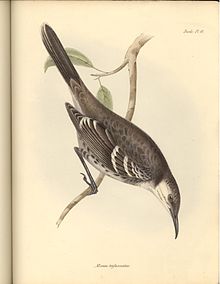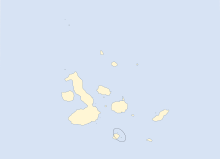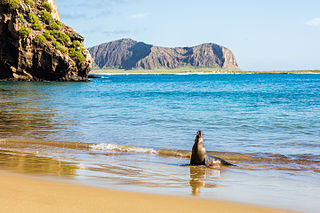
The Galápagos Islands, part of the Republic of Ecuador, are an archipelago of volcanic islands. They are distributed on either side of the equator in the Pacific Ocean, surrounding the centre of the Western Hemisphere. Located 906 km (563 mi) west of continental Ecuador, the islands are known for their large number of endemic species that were studied by Charles Darwin during the second voyage of HMS Beagle. His observations and collections contributed to the inception of Darwin's theory of evolution by means of natural selection.

The mimids are the New World family of passerine birds, Mimidae, that includes thrashers, mockingbirds, tremblers, and the New World catbirds. As their name suggests, these birds are notable for their vocalization, especially some species' remarkable ability to mimic a wide variety of birds and other sounds heard outdoors.

Mockingbirds are a group of New World passerine birds from the family Mimidae. They are best known for the habit of some species mimicking the songs of other birds and the sounds of insects and amphibians, often loudly and in rapid succession. There are about 17 species in two genera, although three species of mockingbird from the Galapagos Islands were formerly separated into a third genus, Nesomimus. The mockingbirds do not appear to form a monophyletic lineage, as Mimus and Melanotis are not each other's closest relatives; instead, Melanotis appears to be more closely related to the catbirds, while the closest living relatives of Mimus appear to be thrashers, such as the sage thrasher.

Darwin's finches are a group of about 18 species of passerine birds. They are well known for their remarkable diversity in beak form and function. They are often classified as the subfamily Geospizinae or tribe Geospizini. They belong to the tanager family and are not closely related to the true finches. The closest known relative of the Galápagos finches is the South American Tiaris obscurus. They were first collected by Charles Darwin on the Galápagos Islands during the second voyage of the Beagle. Apart from the Cocos finch, which is from Cocos Island, the others are found only on the Galápagos Islands.

The tropical mockingbird is a resident breeding bird from southern Mexico to northern and eastern South America and in the Lesser Antilles and other Caribbean islands.

Floreana Island is an island of the Galápagos Islands. It was named after Juan José Flores, the first president of Ecuador, during whose administration the government of Ecuador took possession of the archipelago. It was previously called Charles Island, and Santa María after one of the caravels of Columbus.

The chalk-browed mockingbird is a bird in the family mimidae. It is found in Brazil, Bolivia, Argentina, Paraguay, Suriname, and Uruguay.
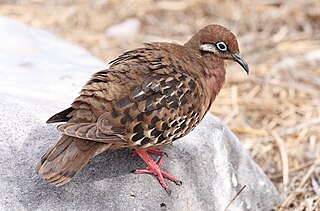
The Galápagos dove is a species of bird in the family Columbidae. It is endemic to the Galápagos, off Ecuador. It is fairly common and is found in a wide range of open and semi-open habitats, especially in the arid lowlands of the archipelago.

Apolinar's wren is a passerine bird in the family Troglodytidae. It is endemic to Colombia.
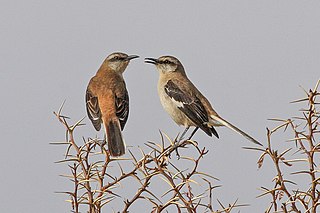
The brown-backed mockingbird is a species of bird in the family Mimidae. It is found in Argentina and Bolivia.

Mimus is a bird genus in the family Mimidae. It contains the typical mockingbirds. In 2007, the genus Nesomimus was merged into Mimus by the American Ornithologists' Union. The genus name is Latin for "mimic".

The Bahama mockingbird is a species of bird in the family Mimidae. It is found in the Bahamas, Cuba, Jamaica and the Turks and Caicos Islands, and is a vagrant to Florida.
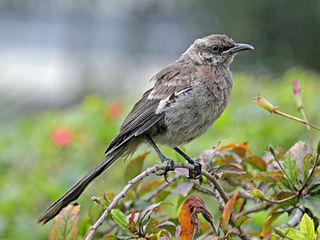
The long-tailed mockingbird is a species of bird in the family Mimidae. It is found in Ecuador and Peru.

The Patagonian mockingbird is a species of bird in the family Mimidae. It is found in much of Argentina and locally in Chile.

The white-banded mockingbird is a species of bird in the family Mimidae. It is found in Argentina, Bolivia, Brazil, Chile, Paraguay, and Uruguay.

The Hood mockingbird, also known as the Española mockingbird, is a species of bird in the family Mimidae. It is endemic to Española Island in the Galápagos Islands, Ecuador, and it is one of four closely related mockingbird species endemic to the Galápagos archipelago. It is found in dry forests and is omnivorous, though it primarily is a carnivore or scavenger. The species has a highly territorial social structure and has no fear of humans. It is the only species of Galápagos mockingbird that Charles Darwin did not see or collect on the voyage of the Beagle.
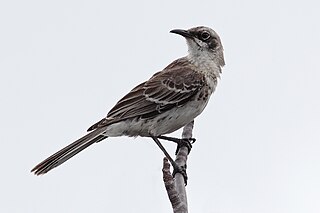
The San Cristóbal mockingbird or Chatham mockingbird, is a species of bird in the family Mimidae. It is endemic to San Cristóbal Island in the Galápagos Islands.

The Galápagos mockingbird is a species of bird in the family Mimidae. It is endemic to the Galápagos Islands, Ecuador.

Cerro Pajas is an inactive volcano located in the south of Floreana Island in the Galápagos Islands, Ecuador. It is the highest peak on Floreana, with a maximum elevation of 640 meters above sea level.
